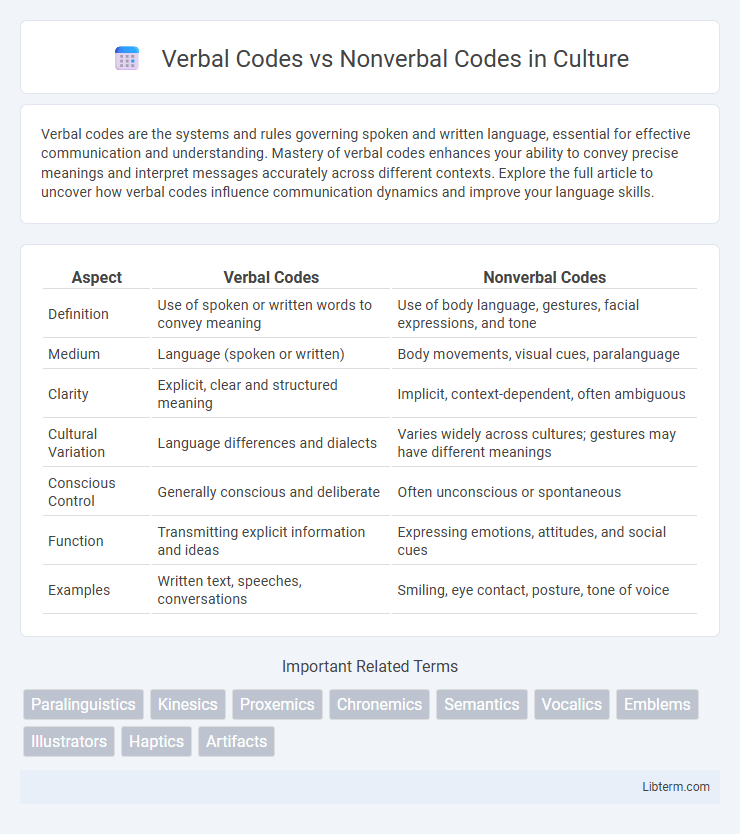Verbal codes are the systems and rules governing spoken and written language, essential for effective communication and understanding. Mastery of verbal codes enhances your ability to convey precise meanings and interpret messages accurately across different contexts. Explore the full article to uncover how verbal codes influence communication dynamics and improve your language skills.
Table of Comparison
| Aspect | Verbal Codes | Nonverbal Codes |
|---|---|---|
| Definition | Use of spoken or written words to convey meaning | Use of body language, gestures, facial expressions, and tone |
| Medium | Language (spoken or written) | Body movements, visual cues, paralanguage |
| Clarity | Explicit, clear and structured meaning | Implicit, context-dependent, often ambiguous |
| Cultural Variation | Language differences and dialects | Varies widely across cultures; gestures may have different meanings |
| Conscious Control | Generally conscious and deliberate | Often unconscious or spontaneous |
| Function | Transmitting explicit information and ideas | Expressing emotions, attitudes, and social cues |
| Examples | Written text, speeches, conversations | Smiling, eye contact, posture, tone of voice |
Introduction to Verbal and Nonverbal Codes
Verbal codes consist of spoken or written language used to convey explicit meanings through words, grammar, and syntax, forming the basis of most direct communication. Nonverbal codes encompass gestures, facial expressions, posture, eye contact, and tone of voice, providing context and emotional nuance that shape the interpretation of verbal messages. Understanding the distinction between verbal and nonverbal codes is essential for effective communication, as both work together to deliver comprehensive and meaningful interactions.
Defining Verbal Communication Codes
Verbal communication codes consist of structured language systems, including words, grammar, and syntax, used to convey explicit messages between individuals. These codes enable precise information exchange through spoken or written language, supported by cultural and contextual variations in meaning. Mastery of verbal codes enhances clarity and reduces misunderstandings in interpersonal and professional communication.
Understanding Nonverbal Communication Codes
Nonverbal communication codes include facial expressions, gestures, posture, eye contact, and proxemics, which convey emotions and intentions beyond spoken words. Understanding these codes requires interpreting cultural context, body language nuances, and paralanguage elements such as tone, pitch, and volume to accurately grasp the message. Mastery of nonverbal communication enhances interpersonal effectiveness and reduces misunderstandings in diverse social and professional interactions.
Key Differences Between Verbal and Nonverbal Codes
Verbal codes involve the use of spoken or written language to convey messages, relying on words, grammar, and syntax for clarity and meaning. Nonverbal codes communicate through body language, facial expressions, gestures, posture, and tone of voice, often conveying emotions and attitudes beyond words. The key difference lies in verbal codes' dependence on language structure, while nonverbal codes emphasize contextual cues and unspoken signals that enhance or modify the meaning of verbal communication.
The Role of Culture in Communication Codes
Culture significantly shapes both verbal and nonverbal communication codes, influencing language use, tone, gestures, and expressions unique to each society. Verbal codes encompass culturally specific vocabulary, syntax, and speech patterns that convey distinct meanings within a cultural context. Nonverbal codes, including eye contact, personal space, and body language, vary widely across cultures, affecting the interpretation and effectiveness of cross-cultural communication.
Functions of Verbal and Nonverbal Codes
Verbal codes primarily function to convey explicit information, articulate thoughts, and structure messages through language, enabling precise communication and the exchange of complex ideas. Nonverbal codes complement verbal communication by expressing emotions, regulating interactions, and providing contextual cues through body language, facial expressions, gestures, and tone of voice. Together, these codes enhance understanding, reinforce messages, and facilitate social bonding by integrating cognitive and affective elements in communication.
Examples of Verbal Codes in Daily Interactions
Verbal codes involve the use of spoken or written language, such as greetings, requests, and instructions, in daily interactions. Examples include saying "thank you," giving directions, or asking questions during conversations. These verbal codes convey explicit information and meaning through words, enabling clear communication in various social and professional settings.
Types of Nonverbal Codes and Their Meanings
Nonverbal codes encompass kinesics (body language and gestures), proxemics (use of personal space), haptics (touch), chronemics (time perception), and paralanguage (vocal tone and pitch), each conveying distinct meanings beyond spoken words. Kinesics reveals emotions and intentions through facial expressions and posture, while proxemics indicates social relationships and dominance by spatial distance. Paralanguage modulates verbal messages with voice modulation, and chronemics reflects cultural attitudes toward punctuality and time management.
Impact of Verbal and Nonverbal Codes in Relationships
Verbal codes, including spoken words and language choice, directly convey explicit messages and shape understanding in relationships, fostering clarity and emotional expression. Nonverbal codes such as facial expressions, gestures, posture, and tone of voice play a crucial role in reinforcing or contradicting verbal communication, influencing trust and emotional intimacy. The interplay between verbal and nonverbal communication significantly impacts relationship satisfaction, conflict resolution, and emotional connection.
Enhancing Communication: Integrating Verbal and Nonverbal Codes
Integrating verbal and nonverbal codes enhances communication effectiveness by providing complementary cues that clarify and reinforce messages. Verbal codes convey explicit content through spoken or written language, while nonverbal codes, including facial expressions, gestures, and body language, transmit emotional context and relational information. Combining both code types reduces misunderstandings and fosters deeper interpersonal connections, optimizing overall communication dynamics.
Verbal Codes Infographic

 libterm.com
libterm.com